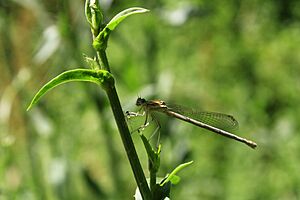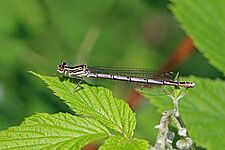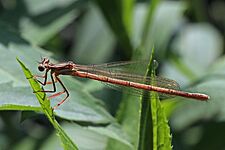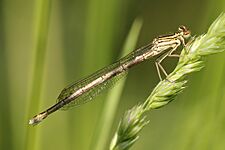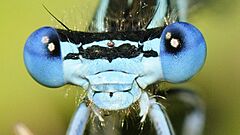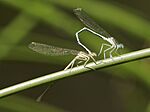White-legged damselfly facts for kids
Quick facts for kids White-legged damselfly |
|
|---|---|
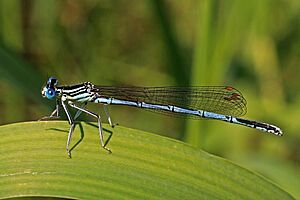 |
|
| Mature male | |
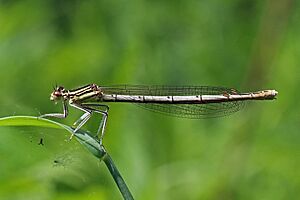 |
|
| Young female both in Warsaw, Poland |
|
| Conservation status | |
| Scientific classification | |
| Genus: |
Platycnemis
|
| Species: |
pennipes
|
The white-legged damselfly or blue featherleg (Platycnemis pennipes) is a type of damselfly. You can often find it near slow-moving, muddy water. These damselflies live in many places, from the Atlantic Ocean all the way to Siberia. They are quite common in these areas.
Contents
What Does the White-legged Damselfly Look Like?
The white-legged damselfly is about 32 millimetres (1.3 in) long. Adult damselflies of this species have some special features. They have wide, white edges on their lower legs, which makes them stand out. They also have black marks in pairs along most of their body. Their head is wider than other damselflies, and they have light brown spots on their wings called pterostigmata.
Differences Between Males and Females
Male white-legged damselflies usually have a pale blue body. Their chest area, called the thorax, often looks a bit greenish. Female damselflies are a very light yellow-green color. They also have black markings on their bodies, similar to the males.
-
An immature female in Estonia.
Where Do White-legged Damselflies Live?
This damselfly species loves muddy rivers that flow slowly. They prefer areas with lots of plants floating on the water. You might even find them in rivers where the tide comes in, as their young can handle slightly salty water. They also live in muddy streams. However, you won't often see them in lakes or ponds. In places like northwest Europe, they mostly stick to flowing water.
Reproduction and Life Cycle
Before mating, the male damselfly performs a special dance. He flutters his white legs in front of the female to impress her. After mating, the female lays her eggs while still connected to the male. They place their long, thin eggs into plant stems that stick out of the water. They especially like to lay eggs on the underside of floating leaves.
The young damselflies, called larvae, live in the mud and debris at the bottom of the water. They stay there for about two years before they are ready to become adults.
Behavior of Adult Damselflies
Once they become adults, these damselflies often gather together. They like to find shelter in tall plants near the water. However, some young damselflies might fly far away from their birthplace. They have been found as far as five kilometers (about three miles) from the nearest water where they could have hatched.



